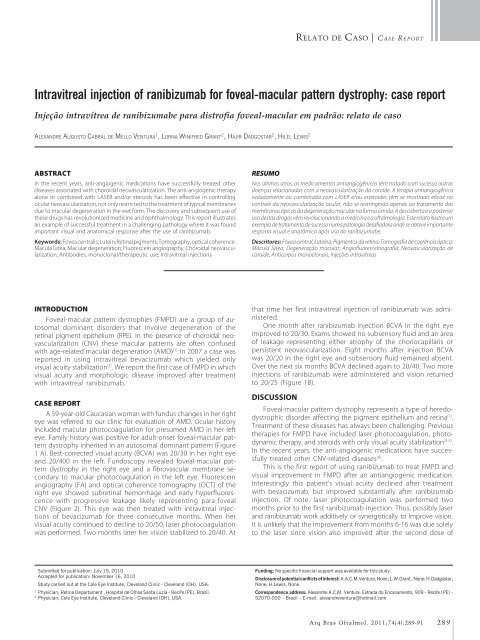Real-time PCR in infectious uveitis Donor eyes - Conselho ...
Real-time PCR in infectious uveitis Donor eyes - Conselho ...
Real-time PCR in infectious uveitis Donor eyes - Conselho ...
Create successful ePaper yourself
Turn your PDF publications into a flip-book with our unique Google optimized e-Paper software.
RELATO DE CASO | CASE REPORT<br />
Intravitreal <strong>in</strong>jection of ranibizumab for foveal-macular pattern dystrophy: case report<br />
Injeção <strong>in</strong>travítrea de ranibizumabe para distrofia foveal-macular em padrão: relato de caso<br />
ALEXANDRE AUGUSTO CABRAL DE MELLO VENTURA 1 , LORNA WINIFRED GRANT 2 , HAJIR DADGOSTAR 2 , HILEL LEWIS 2<br />
ABSTRACT<br />
In the recent years, anti-angiogenic medications have successfully treated other<br />
diseases associated with choroidal neovascularization. The anti-angiogenic therapy<br />
alone or comb<strong>in</strong>ed with LASER and/or steroids has been effective <strong>in</strong> controll<strong>in</strong>g<br />
ocular neovascularization, not only restricted to the treatment of typical membranes<br />
due to macular degeneration <strong>in</strong> the wet form. The discovery and subsequent use of<br />
these drugs has revolutionized medic<strong>in</strong>e and ophthalmology. This report illustrates<br />
an example of successful treatment <strong>in</strong> a challeng<strong>in</strong>g pathology where it was found<br />
important visual and anatomical response after the use of ranibizumab.<br />
Keywords: Fovea centralis; Lute<strong>in</strong>; Ret<strong>in</strong>al pigments; Tomography, optical coherence;<br />
Macula lutea; Macular degeneration; Fluoresce<strong>in</strong> angiography; Choroidal neovascularization;<br />
Antibodies, monoclonal/therapeutic use; Intravitreal <strong>in</strong>jections<br />
RESUMO<br />
Nos últimos anos, os medicamentos antiangiogênicos têm tratado com sucesso outras<br />
doenças relacionadas com a neovascularização da coroide. A terapia antiangiogênica<br />
isoladamente ou comb<strong>in</strong>ada com LASER e/ou esteroides têm se mostrado eficaz no<br />
controle da neovascularização ocular, não se restr<strong>in</strong>g<strong>in</strong>do apenas ao tratamento das<br />
membranas típicas da degeneração macular na forma úmida. A descoberta e o posterior<br />
uso destas drogas vêm revolucionando a medic<strong>in</strong>a e a oftalmologia. Este relato ilustra um<br />
exemplo de tratamento de sucesso numa patologia desafiadora onde se obteve importante<br />
resposta visual e anatômica após uso do ranibizumabe.<br />
Descritores: Fóvea central; Luteína; Pigmentos da ret<strong>in</strong>a; Tomografia de coerência óptica;<br />
Macula lútea; Degeneração macular; Angiofluoresce<strong>in</strong>ografia; Neovascularização de<br />
coroide; Anticorpos monoclonais; Injeções <strong>in</strong>travítreas<br />
INTRODUCTION<br />
Foveal-macular pattern dystrophies (FMPD) are a group of autosomal<br />
dom<strong>in</strong>ant disorders that <strong>in</strong>volve degeneration of the<br />
ret<strong>in</strong>al pigment epithelium (RPE). In the presence of choroidal neovascularization<br />
(CNV) these macular patterns are often confused<br />
with age-related macular degeneration (AMD) (1) . In 2007 a case was<br />
reported <strong>in</strong> us<strong>in</strong>g <strong>in</strong>travitreal bevacizumab which yielded only<br />
visual acuity stabilization (2) . We report the first case of FMPD <strong>in</strong> which<br />
visual acuity and morphologic disease improved after treatment<br />
with <strong>in</strong>travitreal ranibizumab.<br />
CASE REPORT<br />
A 59-year-old Caucasian woman with fundus changes <strong>in</strong> her right<br />
eye was referred to our cl<strong>in</strong>ic for evaluation of AMD. Ocular history<br />
<strong>in</strong>cluded macular photocoagulation for presumed AMD <strong>in</strong> her left<br />
eye. Family history was positive for adult-onset foveal-macular pattern<br />
dystrophy <strong>in</strong>herited <strong>in</strong> an autosomal dom<strong>in</strong>ant pattern (Figure<br />
1 A). Best-corrected visual acuity (BCVA) was 20/30 <strong>in</strong> her right eye<br />
and 20/400 <strong>in</strong> the left. Fundoscopy revealed foveal-macular pattern<br />
dystrophy <strong>in</strong> the right eye and a fibrovascular membrane secondary<br />
to macular photocoagulation <strong>in</strong> the left eye. Fluoresce<strong>in</strong><br />
angiography (FA) and optical coherence tomography (OCT) of the<br />
right eye showed subret<strong>in</strong>al hemorrhage and early hyperfluorescence<br />
with progressive leakage likely represent<strong>in</strong>g para-foveal<br />
CNV (Figure 2). This eye was then treated with <strong>in</strong>travitreal <strong>in</strong>jections<br />
of bevacizumab for three consecutive months. When her<br />
visual acuity cont<strong>in</strong>ued to decl<strong>in</strong>e to 20/50, laser photocoagulation<br />
was performed. Two months later her vision stabilized to 20/40. At<br />
that <strong>time</strong> her first <strong>in</strong>travitreal <strong>in</strong>jection of ranibizumab was adm<strong>in</strong>istered.<br />
One month after ranibizumab <strong>in</strong>jection BCVA <strong>in</strong> the right eye<br />
improved to 20/30. Exams showed no subsensory fluid and an area<br />
of leakage represent<strong>in</strong>g either atrophy of the choriocapillaris or<br />
persistent neovascularization. Eight months after <strong>in</strong>jection BCVA<br />
was 20/20 <strong>in</strong> the right eye and subsensory fluid rema<strong>in</strong>ed absent.<br />
Over the next six months BCVA decl<strong>in</strong>ed aga<strong>in</strong> to 20/40. Two more<br />
<strong>in</strong>jections of ranibizumab were adm<strong>in</strong>istered and vision returned<br />
to 20/25 (Figure 1B).<br />
DISCUSSION<br />
Foveal-macular pattern dystrophy represents a type of heredodystrophic<br />
disorder affect<strong>in</strong>g the pigment epithelium and ret<strong>in</strong>a (1) .<br />
Treatment of these diseases has always been challeng<strong>in</strong>g. Previous<br />
therapies for FMPD have <strong>in</strong>cluded laser photocoagulation, photodynamic<br />
therapy, and steroids with only visual acuity stabilization (3-5) .<br />
In the recent years, the anti-angiogenic medications have successfully<br />
treated other CNV-related diseases (6) .<br />
This is the first report of us<strong>in</strong>g ranibizumab to treat FMPD and<br />
visual improvement <strong>in</strong> FMPD after an antiangiogenic medication.<br />
Interest<strong>in</strong>gly this patient’s visual acuity decl<strong>in</strong>ed after treatment<br />
with bevacizumab, but improved substantially after ranibizumab<br />
<strong>in</strong>jection. Of note, laser photocoagulation was performed two<br />
months prior to the first ranibizumab <strong>in</strong>jection. Thus, possibly laser<br />
and ranibizumab work additively or synergistically to improve vision.<br />
It is unlikely that the improvement from months 6-16 was due solely<br />
to the laser s<strong>in</strong>ce vision also improved after the second dose of<br />
Submitted for publication: July 15, 2010<br />
Accepted for publication: November 16, 2010<br />
Study carried out at the Cole Eye Institute, Cleveland Cl<strong>in</strong>ic - Cleveland (OH), USA.<br />
1<br />
Physician, Ret<strong>in</strong>a Departament , Hospital de Olhos Santa Luzia - Recife (PE), Brazil.<br />
2<br />
Physician, Cole Eye Institute, Cleveland Cl<strong>in</strong>ic - Cleveland (OH), USA.<br />
Fund<strong>in</strong>g: No specific f<strong>in</strong>ancial support was available for this study.<br />
Disclosure of potential conflicts of <strong>in</strong>terest: A.A.C.M.Ventura, None; L.W.Grant , None; H.Dadgostar,<br />
None; H.Lewis, None.<br />
Correspondence address: Alexandre A.C.M. Ventura. Estrada do Encanamento, 909 - Recife (PE) -<br />
52070-000 - Brazil - E-mail: alexandreventura@hotmail.com<br />
Arq Bras Oftalmol. 2011;74(4):289-91<br />
289

















